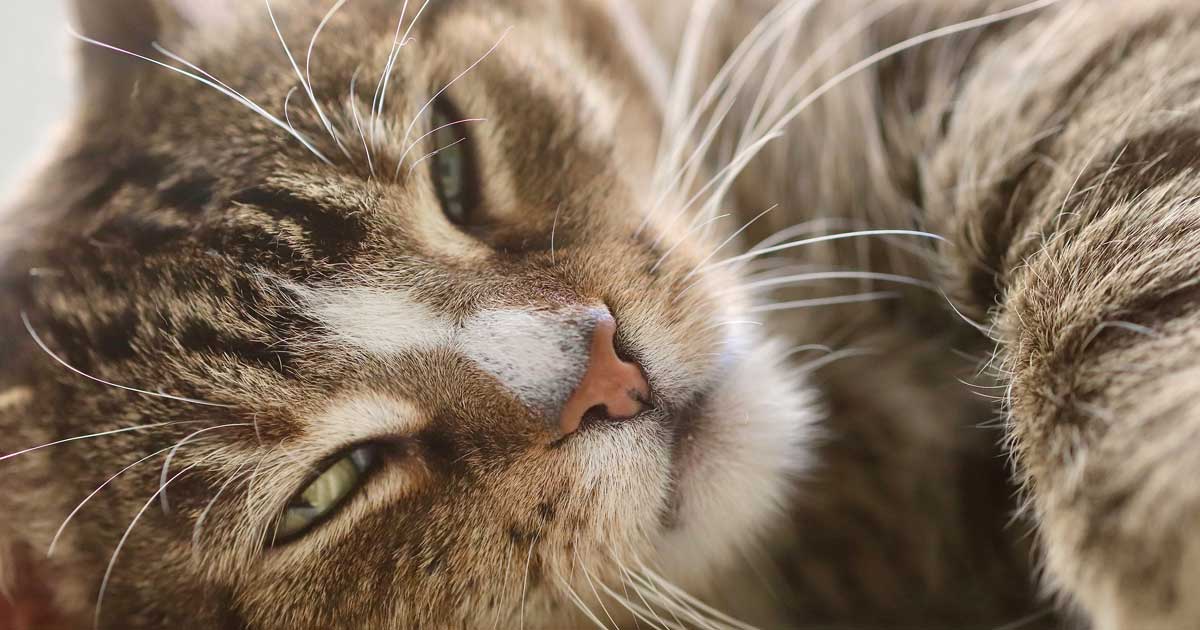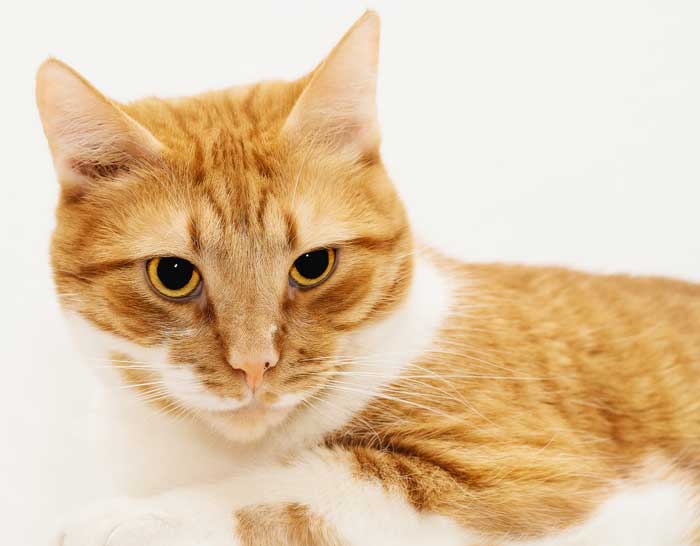16 Jun 2020
Joana Aguiar describes the clinical signs of this issue and how to approach challenging cases, as well as treatment options.

Image © Nennieinszweidrei / Pixabay
Hyperthyroidism is the most common feline endocrinopathy, affecting between 1.5% and 11.4% of cats older than nine years of age worldwide1-5.
It is a multisystemic disorder characterised by hypermetabolism resulting from excessive production of tri-iodothyronine (T3) and thyroxine (T4) by autonomous thyroid follicular cells3,5.
Thyroid nodular hyperplasia, adenomatous hyperplasia and adenoma are the most commonly described histopathological changes associated with feline hyperthyroidism, with only 2% of hyperthyroid cats being diagnosed with thyroid carcinoma1,3,6.
Feline hyperthyroidism was first described in 19797,8. Since then, its worldwide prevalence has been increasing – and the reasons for this are most likely multifactorial5. Raised awareness of the condition, widespread availability of diagnostic tests and ageing of the cat population may play a role. However, environmental, genetic, hereditary and goitrogenic risk factors – such as dietary components, additives and pollutants – may also contribute1,6,9-11.
Feline hyperthyroidism remains a major area of interest within the veterinary field, given that causal factors are still not fully understood1-3,5.

With regards to diagnosis, signalment is certainly an important aspect. Cats diagnosed with hyperthyroidism are usually senior or geriatric, although it can occasionally be diagnosed in cats younger than nine years of age5.
A few cat breeds have been previously identified as having decreased risk for development of hyperthyroidism – such as the Siamese, Himalayan, Burmese, Tonkinese, Persian, Abyssinian and British shorthair9,12,13. Notably, many of these are colourpoint – where tyrosinase mutations may affect tyrosine organification in thyrocytes, or alter tyrosine availability for thyroid hormone synthesis13.
Many clinical signs and findings have been described in cats with hyperthyroidism, including palpable goitre, weight loss, polyphagia, polydipsia/polyuria, sarcopenia, tachycardia, cardiac murmurs, hyperactivity and increased vocalisation, vomiting and diarrhoea, mild erythrocytosis, and mild to moderately raised liver enzymes activities – particularly serum alanine transferase5,9,14-16. However, not all hyperthyroid cats present all clinical signs and findings – particularly if diagnosed quite early in the disease progress5.
Furthermore, some may even present with atypical clinical signs, such as lethargy and reduced appetite – commonly referred to as “apathetic” hyperthyroidism. This makes the diagnosis of hyperthyroidism less than straightforward5.
In practice, most cats are diagnosed with hyperthyroidism when presenting with one or more of the aforementioned clinical signs and findings, and have a concurrently raised serum total T4 concentration5,6,17. However, in some cases, definitive diagnosis may require additional investigations – such as measurement of serum thyroid-stimulating hormone (TSH) and free T4 concentrations – as well as scintigraphy5.
The presence of concomitant non‑thyroidal diseases – such as hepatic disease, diabetes mellitus, chronic kidney disease and gastrointestinal disease – may also make the diagnosis of hyperthyroidism more challenging, given that clinical signs will overlap and mild to moderate suppression of thyroid hormone synthesis may occur (euthyroid-sick syndrome)5,18. Therefore, it is important to revisit the potential diagnosis of hyperthyroidism once the other disease processes have subsided or are better controlled5.
A systematic and categorical approach to the diagnosis of feline hyperthyroidism has been described in the 2016 American Association of Feline Practitioners (AAFP) Guidelines for the Management of Feline Hyperthyroidism5. These guidelines provide the required information for the diagnosis of more challenging cases.
In summary, cats with clinical signs consistent with hyperthyroidism and a serum total T4 concentration within normal limits should have serum TSH and/or free T4 concentrations measured, or scintigraphy performed, and further investigations performed with the aim of identifying the presence of any concurrent illness5,18,19. Should all these investigations be unremarkable, monitoring is recommended by means of repeating measurement of serum total T4 concentration a few weeks later18.
The presence of goitre in the absence of clinical signs and a normal serum total T4 concentration, again prompts to ongoing monitoring and repeat serum total T4 concentration measurement at least six months later18.
Cats without overt clinical signs, but with clinical findings on examination consistent with feline hyperthyroidism, and persistently raised serum total T4 concentration should be started on treatment. Similarly, cats with no overt clinical signs or findings compatible with hyperthyroidism, but with persistently raised serum total T4 concentrations, should receive treatment5.
Various treatment options are available for management of feline hyperthyroidism. These include radioactive iodine (RAI) treatment, oral or transdermal medical treatment, surgical thyroidectomy and dietary therapy5,6,17.
Any treatment option has its advantages and disadvantages, and these should be carefully discussed with owners to choose the best treatment option for each cat. Discussion of the advantages and disadvantages associated to each treatment option is beyond the focus of this article, but these can be downloaded from the AAFP website (https://bit.ly/2Unu7Ev) in the form of a chart that can be provided to owners to facilitate discussion.
While the cost of radioactive iodine or surgery can be considerable, ongoing long-term cost of medical or dietary treatments may reach similar values over the cat’s life5.
Cats treated with RAI are expected to become euthyroid by 2 to 12 weeks after a single injection of iodine-131, with a treatment success rate greater than 95%5,20.
The 5% of patients that do not respond to a single dose of iodine-131 usually have higher serum T4 concentrations, more severe clinical signs, larger goitres or thyroid carcinomas3,5.
If a thyroid carcinoma is not present, a second dose of iodine-131 is usually effective. A higher dose of iodine-131 is required for treatment of thyroid carcinomas21.
Cats treated with iodine-131 must be monitored for the development of hypothyroidism at least at three months and six months post-treatment, as hypothyroidism will impact their renal function and the function of other vital organs5.
Up to 75% of cats will have a low total T4 concentration following treatment, at least transiently. However, fewer than 30% of cats will remain hypothyroid three months following RAI treatment5,22,23.
Cats with bilateral disease on scintigraphy have been found to be twice as likely to develop hypothyroidism after iodine-131 than cats with unilateral disease23.
Therapy with L-thyroxine sodium (75µg/cat to 100µg/cat, orally twice daily) is usually recommended to cats that are hypothyroid (T4 lower than 10nmol/L to 15nmol/L and TSH greater than 0.15nmol/L) and azotaemic three months following iodine-131 treatment. Cats diagnosed with iatrogenic hypothyroidism have a greater incidence of azotaemia22.
Should no azotaemia or other clinical signs be present at three months following iodine‑131 treatment, no need exists to start L-thyroxine sodium supplementation, unless the cat remains hypothyroid at six months.
Once therapy has been initiated, serum total T4 concentration can be monitored every 6 months to 12 months. A blood sample should be taken four hours to six hours after the morning dose of L-thyroxine sodium18.

Cats receiving oral or transdermal medical treatment require close monitoring of serum total T4 concentrations.
Carbimazole and thiamazole doses should be titrated to effect, with the aim of reducing serum total T4 concentrations to the lower half of the reference interval24. Over time, dose and frequency of administration adjustments may be required as the number and size of the thyroid nodules continues to increase25.
Initially, serum T4 concentration can be measured three to four weeks after starting therapy and until the lowest effective dose is determined26. Once stable, cats can be checked every four to six months18. Medical treatment can be continued long‑term or used to stabilise the patient prior to thyroidectomy18.
Transdermal methimazole is effective and less often associated with gastrointestinal side effects; however, studies have shown patients may take longer to return to euthyroidism when compared to oral treatment18,27. Furthermore, transdermal methimazole is not a veterinary licensed product; therefore, it should only be used in situations where a justification exists for not using licensed medications (oral thiamazole and carbimazole), surgery or RAI.
Side effects commonly associated with treatment with thiamazole and carbimazole include vomiting and diarrhoea (15% of cases), self-induced facial excoriations, agranulocytosis and thrombocytopenia (fewer than 5% of cases) and hepatotoxicity (fewer than 2% of cases)18,24. Neither the frequency or severity of these side effects has been found to be dose‑dependent and these become less common after two to three months of therapy24,28.
Carbimazole is converted into methimazole once metabolised; therefore, if a cat develops side effects with one drug, it will most certainly develop them with the other18,24. Drug-related side effects have also been reported in humans receiving these drugs. Therefore, it is important for owners to wear gloves when administering the coated tablets or the transdermal formulation to cats.
Surgical thyroidectomy is ideally performed in cats that have previously received medical treatment and are, therefore, more cardiovascularly stable. This will reduce the anaesthetic risk associated with the procedure18.
Bilateral intracapsular thyroidectomy is usually recommended to preserve the parathyroid glands in situ and avoid the need for a second surgery. The latter is particularly relevant, given that both thyroid glands are affected in two thirds of cases3,6.
Transient to permanent hypocalcaemia is seen in between 6% and 82% of cases, depending on the surgical technique chosen5,18,29. It is, therefore, recommended to closely monitor serum calcium concentrations every 24 hours to 48 hours during the first week following surgery. Calcium and vitamin D supplementation may be required in some cases18.
Laryngeal nerve paralysis and Horner’s syndrome have also been described as potential complications associated with thyroidectomy in cats30.
Scintigraphy is of great value prior to thyroidectomy as a means to identify unilateral versus bilateral thyroid disease; the presence of ectopic thyroid tissue, which has been reported to occur in between 4% and 20% of cases; or if goitre extends into the thoracic inlet and sternum. The latter makes surgical resection more challenging17. Scintigraphy may also raise the index of suspicion for the presence of a thyroid carcinoma5,18.
Because of the short half-life of cats’ thyroid hormones, euthyroidism may be achieved 24 hours to 48 hours post-thyroidectomy17. However, serum T4 concentrations are usually checked four weeks to six weeks post‑surgery and then, should the disease be well‑controlled, every four months to six months, or earlier if a recurrence of the clinical signs is seen18.
Bilateral thyroidectomy may lead to the development of hypothyroidism – supplementation with L‑thyroxine sodium may be required as discussed post-treatment with iodine-1315,6,18.
An iodine-restricted diet is available as a treatment option for cats with hyperthyroidism18. However, a few facts need to be considered prior to prescribing this diet:
Cats suffering from severe thyrotoxicosis (very high T4 concentration) may take up to six months to have their hyperthyroidism clinically controlled with diet.
No studies exist looking at the long-term effects of iodine restriction in cats.
Cats fed this diet must be completely indoor cats, with no access to other food sources of iodine, and must only be offered bottled water for the same reason.
Some medications contain iodine and, therefore, may not be compatible with dietary management of hyperthyroidism5.
Cats fed an iodine-restricted diet showed reduction of their serum creatinine concentrations, despite serum T4 concentrations being within normal limits, and many have not experienced an increase in bodyweight. These may be related, or an indication the disease is not well-controlled with dietary management, and, therefore, this treatment modality should only be used if cats cannot be treated in another way.
Cats being fed an iodine-restricted diet should initially have their serum T4 concentration measured three weeks to four weeks after starting the diet, although, in one study, only 75% of cats had significant reduction of serum T4 concentration at 28 days of diet treatment18,31. Further monitoring is required to evaluate whether serum T4 concentrations are reducing over time and, once these have stabilised, then monitoring frequency can be reduced to two to three times yearly18.
The diagnosis of feline hyperthyroidism is not always straightforward; however, the AAFP guidelines can be used for more challenging cases. It is an endocrinopathy for which different treatment options are available.
Independently of the treatment modality, close long-term monitoring is required to achieve a good control of the disease and for management of any comorbidities.